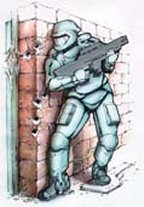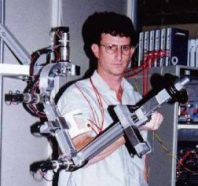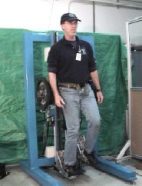Supersuits for Superheroes
Becoming stronger may someday mean putting on a robotic suit.
By Emily Sohn
Just by getting dressed in the morning, you could jump 10 feet into the air, carry 150 pounds without getting tired, and throw a baseball faster than Roger Clemens.
Such supercharged clothing is one possible product of a new technology called “wearable robotics.” Designed to enhance a person’s senses and skills, the apparatus could be as simple as a hearing aid. Or it could be as complex as a full-body suit that senses what you’re going to do, then helps you do it better.
“A Superman suit would be the ultimate in wearable robotics,” says François Pin of the Oak Ridge National Laboratory in Tennessee. He’s head of the robotics and energetic systems group.
Superman and Superwoman suits are at least a decade away. But other applications for the technology are already in the works.
 |
|
A form-fitting robotic suit, or exoskeleton, could help a trooper on the battlefield. |
| Defense Advanced Research Projects Agency |
The U.S. Army is interested in using wearable robotics to help soldiers run faster, carry more gear, and be stronger in battle. The technology could also transform jobs that involve lifting heavy loads, rescuing survivors from the rubble of an earthquake, or collecting garbage.
The first people to benefit from this technology, however, will probably be the elderly, handicapped, and injured. Researchers are developing artificial arms and legs, for example, that work almost as if they were living parts of a person’s body.
Someday, wearable robotics could make life easier for all of us. It might even be the secret ingredient for building the next generation of superathletes.
Command and control
A robot is essentially a device that responds to a command. You’ve probably played with simple robots, such as toy cars or airplanes that respond to buttons you push on a remote control.
Wearable robotics goes a step further, says biomedical engineer Jacob Rosen. He heads the biorobotics lab at the University of Washington in Seattle. Instead of just receiving information through a wire or remote control, the robotic device also sends information back to its controller in a so-called feedback loop.
Suppose you wore a sleeve that has sensors where your joints are. Every time you move your arm, the sleeve senses your movements and sends the information to a robot, which then moves its arm just as you did. When the robot hits or touches something, it sends a signal back to the sleeve and you sense the impact.
Scientists are now working to wrap the robot around the person. Ideally, the sleeve or shoe or suit would do more than just sense your movements and send feedback. It would also help you do what you want to do.
 |
|
This robotic arm senses what its human operator is trying to do. |
| Biorobotics Lab/University of Washington |
The problem is that ordinary sensors and feedback loops are too slow. “You always feel like you’re dragging something behind you,” Rosen says. This sluggishness defeats the purpose of the technology.
One way to speed up response is to take advantage of the body’s nervous system.
Whenever you move, your brain sends signals through your nervous system to muscle tissue, which then allows you to walk, run, punch, pinch, blink, swallow, jump, whatever. Even though you perform many of these actions without even thinking about them, there’s a tiny delay between command and action.
Depending on the distance between the brain and the targeted muscle, it takes between 20 and 200 milliseconds for such a message to travel to its destination, Rosen says.
Robot nerves
That’s just enough time for an electronic device to step in. Tiny computers implanted in the nervous system could intercept signals coming from the brain and tell the robot what to do, just as the muscle itself is about to do it. A well-designed device could even one-up the muscle and do the movement better.
Rosen has already designed one robotic elbow joint and two shoulder joints that work in this way. He’s now building a fully functioning robotic arm.
“It’s a very weird feeling,” Rosen says. It’s as if the robot that you’re wearing actually knows what you’re going to do.
A research group at Duke University has gone one step further. Instead of tapping into signals at the muscle tissue, the team has put wires directly into a monkey’s brain. A wired monkey need do nothing more than think about moving a robotic arm to cause the arm to move.
Both approaches have advantages and disadvantages, Rosen says, and many obstacles remain.
Walking systems, for instance, are probably at least 5 years from being practical because they require so much power, Rosen says. People would have to carry a huge, heavy battery to make them work. Pin’s group is looking for alternative power sources, such as fuel cells, that are lighter and more compact than current batteries.
Full suits, called exoskeletons, would also be extremely expensive. So, even with advances over the next few years, Pin says, Superman and Superwoman suits won’t show up at The Gap or even Radio Shack anytime soon.
Future visions
Still, the potential of tapping into brain and muscle signals is hard to ignore, especially for medical and military applications.
Doctors could implant arms and legs that would move as if people were born with them. Paralyzed people could walk again.
 |
|
This contraption amplifies a person’s foot strength. |
| Oak Ridge National Laboratory |
Pin envisions exercise machines that help people recover from injuries. He predicts tiny medical devices inside the body that deliver medicine to specific locations. I imagine special shoes or shorts that could help me run faster, climb higher, or carry more weight without ever getting tired.
Soldiers in exoskeletons would be able to fight in places where tanks or armored vehicles couldn’t go. They could carry hundreds of pounds of ammunition and high-tech gizmos, including night-vision goggles, navigation devices, and sensors that detect an injury and order the suit to walk away on its own.
Combined with virtual reality, the technology could help with construction and maintenance tasks in remote or awkward places. After putting on an exoskeleton suit and goggles, an aerospace engineer would simply move his hands to fix intricate parts of a space shuttle without ever even setting foot near the vehicle. A robot on the spacecraft would do whatever the engineer did.
Could the technology also change entertainment or sports? Let your imagination go, and you still probably won’t come up with half the things wearable robotics might do for us someday.
Going Deeper:







